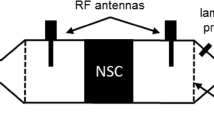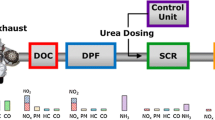Abstract
Since the ammonia (NH3) based selective catalytic reduction is today’s main DeNOx strategy to meet the emission limits for Diesel cars, research focuses on sensor and control approaches for higher conversion efficiencies and system robustness. One novel approach is the catalyst state monitoring based on radio frequencies (RF). It has proven its functionality to monitor the NH3 loading on SCR catalysts directly in previous studies. This study shows the first attempt to fully describe the whole RF SCR system by simulation. A divided model into the chemical reactions and the RF response is presented and parameterized on experimental test runs. The application of the adjusted model on a test run that was not included in parameter fitting correlates well with the simulated signals and the measured catalyst behavior as well as with the RF response.







Similar content being viewed by others
References
Koebel M, Elsener M, Marti T (1996) NOx-reduction in diesel exhaust gas with urea and selective catalytic reduction. Combust Sci Tech 121:85–102. https://doi.org/10.1080/00102209608935588
Forzatti P (2001) Present status and perspectives in de-NOx SCR catalysis. Appl Catal A 222(1–2):221–236. https://doi.org/10.1016/S0926-860X(01)00832-8
Guan B, Zhan R, Lin H, Huang Z (2014) Review of state of the art technologies of selective catalytic reduction of NOx from diesel engine exhaust. Appl Therm Eng 66(1–2):395–414. https://doi.org/10.1016/j.applthermaleng.2014.02.021
Koebel M, Elsener M (1998) Selective catalytic reduction of NO over commercial DeNOx-catalysts: experimental determination of kinetic and thermodynamic parameters. Chem Eng Sci 53(4):657–669. https://doi.org/10.1016/S0009-2509(97)00342-4
Yuan X, Liu H, Gao Y (2015) Diesel engine SCR control: current development and future challenges. Emiss Control Sci Technol 1(2):121–133. https://doi.org/10.1007/s40825-015-0013-z
Opitz B, Bendrich M, Drochner A, Vogel H, Hayes RE, Forbes JF, Votsmeier M (2015) Simulation study of SCR catalysts with individually adjusted ammonia dosing strategies. Chem Eng J 264:936–944. https://doi.org/10.1016/j.cej.2014.11.114
Moos R (2010) Catalysts as sensors—a promising novel approach in automotive exhaust gas aftertreatment. Sensors 10(7):6773–6787. https://doi.org/10.3390/s100706773
Moos R (2015) Microwave-based catalyst state diagnosis—state of the art and future perspectives. SAE Int J Engines 8(3):1240–1245. https://doi.org/10.4271/2015-01-1042
Chen P, Schönebaum S, Simons T, Rauch D, Dietrich M, Moos R, Simon U (2015) Correlating the integral sensing properties of zeolites with molecular processes by combining broadband impedance and DRIFT spectroscopy—a new approach for bridging the scales. Sensors 15:28915–28941. https://doi.org/10.3390/s151128915
Rauch D, Kubinski D, Cavataio G, Upadhyay D, Moos R (2015) Ammonia loading detection of zeolite SCR catalysts using a radio frequency based method. SAE Int J Engines 8(3):1126–1135. https://doi.org/10.4271/2015-01-0986
Dietrich M, Rauch D, Simon U, Porch A, Moos R (2015) Ammonia storage studies on H-ZSM-5 zeolites by microwave cavity perturbation: correlation of dielectric properties with ammonia storage. J Sens Sens Syst 4(2):263–269. https://doi.org/10.5194/jsss-4-263-2015
Dietrich M, Hagen G, Reitmeier W, Burger K, Hien M, Grass P, Kubinski D, Visser J, Moos R (2017) Radio-frequency-controlled urea dosing for NH3-SCR catalysts: NH3 storage influence to catalyst performance under transient conditions. Sensors 17:2746. https://doi.org/10.3390/s17122746
Rauch D, Dietrich M, Simons T, Simon U, Porch A, Moos R (2017) Microwave cavity perturbation studies on H-form and Cu Ion-exchanged SCR catalyst materials: correlation of ammonia storage and dielectric properties. Top Catal 60:243–249. https://doi.org/10.1007/s11244-016-0605-z
Dietrich M, Steiner C, Hagen G, Moos R (2017) Radio-frequency-based urea dosing control for diesel engines with ammonia SCR catalysts. SAE Int J Engines 10(4):1638–1645. https://doi.org/10.4271/2017-01-0945
Deutschmann O (2015) Modeling of the interactions between catalytic surfaces and gas-phase. Catal Lett 145(1):272–289. https://doi.org/10.1007/s10562-014-1431-1
Olsson L, Wijayanti K, Leistner K, Kumar A, Joshi SY, Kamasamudram K, Currier NW, Yezerets A (2015) A multi-site kinetic model for NH3-SCR over Cu/SSZ-13. Appl Catal B 174:212–224. https://doi.org/10.1016/j.apcatb.2015.02.037
Wang TJ, Baek S, Kwon HJ, Kim YJ, Nam I-S, Cha M-S, Yeo GK (2011) Kinetic parameter estimation of a commercial Fe-Zeolite SCR. Ind Eng Chem Res 50(5):2850–2864. https://doi.org/10.1021/ie101558d
Toops TJ: The measured and proposed chemistry of the Selective Catalytic Reduction of NOx, Modegat IV, 14.09.2015, Bad Herrenalb, Germany
Nova I, Colombo M, Tronconi E (2011) Kinetic modeling of dynamic aspects of the standard NH3-SCR reaction over V2O5-WO3/TiO2 and Fe-zeolite commercial catalysts for the aftertreatment of diesel engines exhausts. Oil Gas Sci Technol 66(4):681–691. https://doi.org/10.2516/ogst/2011132
Dietrich M, Hagen G, Moos R (2019) Dielectric properties and temperature dependency of automotive catalyst coatings and substrate materials: experimental results, influences and approximation approach. Func Mater Lett. in press. https://doi.org/10.1142/S1793604719500243
Author information
Authors and Affiliations
Corresponding author
Additional information
Publisher’s Note
Springer Nature remains neutral with regard to jurisdictional claims in published maps and institutional affiliations.
Rights and permissions
About this article
Cite this article
Dietrich, M., Hagen, G. & Moos, R. Modelling Both the NH3 Storage on Automotive SCR Catalysts and the Radio-Frequency-Based Response. Top Catal 62, 172–178 (2019). https://doi.org/10.1007/s11244-019-01140-x
Published:
Issue Date:
DOI: https://doi.org/10.1007/s11244-019-01140-x




